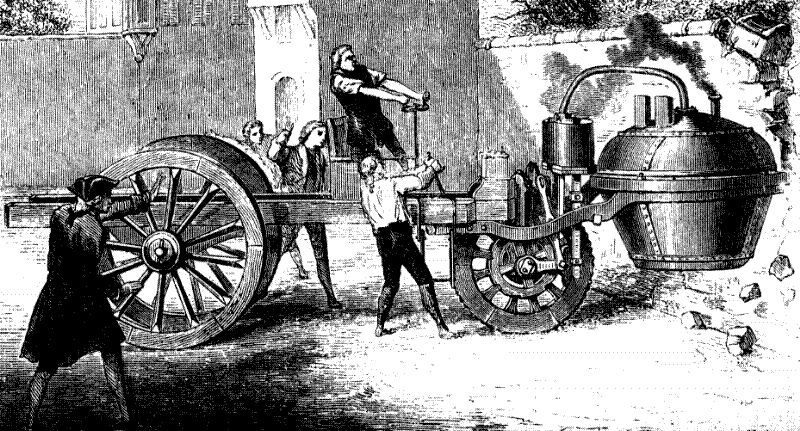The world’s first self-propelled mechanical vehicle, in other words, the world’s first automobile, was built by the largely unknown French inventor Nicolas-Joseph Cugnot.
Nicholas-Joseph Cugnot was born in Void-Vacon, Lorraine, in 1725 and was trained as a military engineer. Tasked by the army to develop a steam-powered vehicle for the purpose of hauling cannon, Cugnot devised a scaled-down working model in 1769, and in 1770, he unveiled a full-sized steam-driven vehicle, which he called a fardier à vapeur. The vehicle was modelled after the fardier, which was a massively built two-wheeled horse-drawn cart for transporting very heavy equipment, such as cannon barrels. Instead of having a horse at the front, there was a third wheel, which supported a large copper boiler and the driving mechanism. Cugnot was one of the first to successfully employ a device for converting the reciprocating motion of a steam piston into a rotary motion by means of a ratchet arrangement, which was used to drive the front wheel.
Joseph Cugnot's 1770 Fardier à Vapeur, at the Musée des arts et métiers, Paris. Photo: Joe deSousa/Wikimedia Commons
The fardier à vapeur could reputedly move at a little over 2 miles per hour, but it needed to be refueled with wood and relit every 15 minutes, for which the fardier had to come to a complete stop. The vehicle was reported to have been very unstable owing to poor weight distribution, a serious disadvantage for a vehicle intended to be able to traverse rough terrain and climb steep hills. In addition, boiler performance was also particularly poor, even by the standards of the day. In 1771, during a trial Cugnot drove one of his vehicles into a stone wall, giving the inventor the distinct honor of being the first person to get into a motor vehicle accident. The story goers that Cugnot was arrested and convicted of dangerous driving, another first for him if true.
After several trials, the project was abandoned by the French Army. Nevertheless, the development was so impressive that King Louis XV awarded Cugnot a pension of 600 Livres a year for his ingenuity. Unfortunately, the French Revolution cut off the pension, and the inventor withdrew to Brussels, where he lived in poverty. Shortly before his death, Cugnot's pension was restored by Napoleon Bonaparte and he eventually returned to Paris where he died on 2 October 1804.
The first automobile accident.
Incredibly, the fardier à vapeur survived and can still be seen at the Musée des Arts et Métiers in Paris.
In 2010, a copy of the “fardier de Cugnot” was built by some of the pupils from ParisTech, in conjunction with Cugnot's native commune of Void-Vacon. The replica worked perfectly demonstrating the validity of the concept. It was exhibited at the Paris Motor Show and it currently visible at the native village of Cugnot, at Void-Vacon.
Another replica was built by the Tampa Bay Automobile Museum in 2014. The boiler was fed with a supply of oak, and after about 45 minutes there was enough steam to push the vehicle forward at about 3 to 4 mph. “It only needs one person to drive,” said Susan Cerf a spokesperson for the museum. “But it's pretty slow and cumbersome. It'll go about 100 yards before it needs to be recharged, and the steam and smoke all blow back in the driver's face.”
A replica of Joseph Cugnot’s Fardier à vapeur being driven at Grenoble, France, in 2012. Photo: Frédérique Voisin-Demery/Flickr
References:
# Nicholas-Joseph Cugnot and the Automobile, SciHi Blog
# Nicolas-Joseph Cugnot, Wikipedia
# Daniel Strohl, Working replica of oldest vehicle in the world to appear at Stan Hywet Concours, Hemmings















Comments
Post a Comment